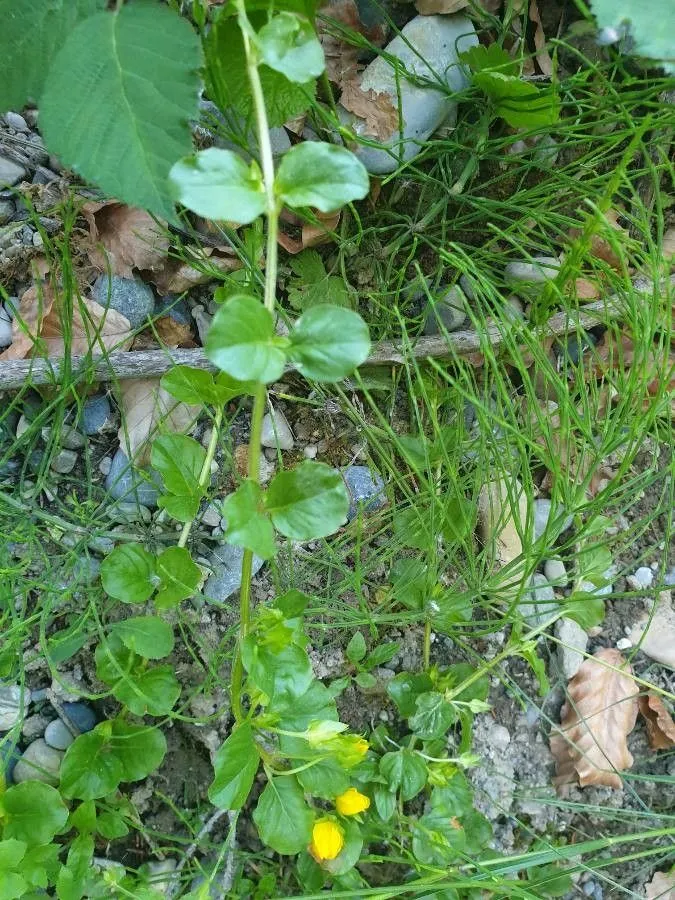
Author: L.
Bibliography: Sp. Pl.: 148 (1753)
Year: 1753
Status: accepted
Rank: species
Genus: Lysimachia
Vegetable: False
Observations: Europe
The Yellow Pimpernel, scientifically known as Lysimachia nemorum, is a perennial herbaceous plant native to Europe. This charming plant is a member of the Primulaceae family and is well-regarded for its delicate beauty and subtle presence in the wild.
Characterized by its bright yellow, star-shaped flowers, the Yellow Pimpernel blooms typically from late spring to early autumn. Each flower is small, yet striking, often attracting the attention of various insects and pollinators. The flowers possess five distinct petals that radiate around a central point, creating a simple yet elegant display.
Growing primarily in moist, shaded environments such as woodlands and along stream banks, Lysimachia nemorum thrives in conditions where it can take advantage of the dappled light filtering through the canopy above. Its preference for these habitats highlights its adaptability to cooler, humid microclimates.
The leaves of the Yellow Pimpernel are another notable feature. They are opposite, ovate to almost heart-shaped, and sit on short stalks. The lush greenery of the leaves provides a vivid contrast to the bright yellow flowers, making the plant easily identifiable for nature enthusiasts and botanists alike.
Historical botanical references, such as the one from “Species Plantarum” published in 1753, authored by the influential botanist Carl Linnaeus (denoted simply as ‘L.’), underscore the plant’s longstanding recognition and classification in the scientific community.
In addition to its visual appeal, the Yellow Pimpernel also holds ecological significance. It plays a role in supporting local biodiversity, offering nectar and pollen to insects, and contributing to the intricate web of plant and animal interactions within its native habitats.
For those interested in cultivating Lysimachia nemorum in a garden setting, it is recommended to mimic its natural environment by ensuring ample moisture and placing it in a shaded or semi-shaded location. This will help the plant to establish and flourish, bringing a touch of European woodland charm to garden landscapes.
In summary, the Yellow Pimpernel, Lysimachia nemorum, is a delightful and ecologically valuable plant native to Europe. Its elegant yellow flowers, coupled with its preference for moist, shaded areas, make it a noteworthy member of the Primulaceae family and a cherished species among plant enthusiasts and ecologists alike.
Deu: hain-gilbweiderich
Dan: lund-fredløs
Nld: boswederik
Fra: lysimaque des bois
Swe: skogslysing, gularv
Eng: yellow pimpernel
Cym: aur y tywydd, gwlydd melyn mate, gwlyddyn melyn mair, melyn y tywydd, seren felen, seren felyn, seren y cloddiau, trewynyn y coed, trewynyn y goedwig
En: Yellow pimpernel, Wood pimpernel
Ca: Lisimàquia de bosc
Kw: Brathles melyn
Cs: Vrbina hajní
Da: Lund-fredløs
Nl: Boswederik
Fi: Lehtoalpi
Fr: Lysimaque des bois, Lysimaque des forêts, Mouron jaune
De: Hain-Gilbweiderich, Gelber-Waldpimpernel, Hainfelberich, Wald-Gilbweiderich, Wald-Lysimachie
Hu: Berki lizinka
Ga: Lus Cholm Cille
It: Mazza d’oro boschiva, Mazza-d’oro boschiva
No: Skogfredlaus, Skogfredløs
Pl: Tojeść gajowa
Sk: Čerkáč hájny
Sv: Skogslysing, Gularv
Uk: Вербозілля гайове
Cy: Gwlyddyn melyn Mair, Aur y Tywydd, Gwlydd Melyn Mate, Melyn y Tywydd, Seren Felen, Seren Felyn, Seren y Cloddiau, Trewynyn y Coed, Trewynyn y Goedwig
Taken Jun 8, 2007 by Tela Botanica − Liliane Roubaudi (cc-by-sa)
Taken Apr 24, 2015 by Tela Botanica − Yoan MARTIN (cc-by-sa)
Taken May 30, 2022 by herboso (cc-by-sa)
Taken Jun 15, 2021 by Pierre LEON (cc-by-sa)
Taken May 27, 2020 by Matt P. Walser (cc-by-sa)
Taken Aug 11, 2021 by Noel Benson (cc-by-sa)
Taken Jun 15, 2021 by Pierre LEON (cc-by-sa)
Taken Jun 17, 2021 by Marzena samo Zło (cc-by-sa)
Taken Oct 26, 2021 by Marina R (cc-by-sa)
Taken May 27, 2020 by Matt P. Walser (cc-by-sa)
Taken Jun 17, 2021 by Marzena samo Zło (cc-by-sa)
Taken Jun 12, 2021 by fienchen (cc-by-sa)
Taken May 27, 2020 by Matt P. Walser (cc-by-sa)
Taken Jun 24, 2022 by Brian Angell (cc-by-sa)
Taken May 26, 2018 by vmattes (cc-by-sa)
Taken Jun 18, 2022 by Petr Harant (cc-by-sa)
Taken May 12, 2018 by huy HO (cc-by-sa)
Taken May 24, 2020 by Geneviève Petit (cc-by-sa)
Taken Apr 24, 2015 by Tela Botanica − Yoan MARTIN (cc-by-sa)
Taken Jun 13, 2014 by Tela Botanica − Françoise CARLE (cc-by-sa)
Taken May 8, 2022 by Pierre LEON (cc-by-sa)
Taken Jun 20, 2019 by Mattheus Bleijenberg (cc-by-sa)
Taken Jun 13, 2010 by Martin Bishop (cc-by-sa)
Taken May 12, 2012 by Tela Botanica − Yoan MARTIN (cc-by-sa)
Taken May 4, 2011 by Tela Botanica − Yoan MARTIN (cc-by-sa)
Taken Jul 5, 2019 by Peter Vohwinkel (cc-by-sa)
Taken May 12, 2012 by Tela Botanica − Yoan MARTIN (cc-by-sa)
© copyright of the Board of Trustees of the Royal Botanic Gardens, Kew.
© copyright of the Board of Trustees of the Royal Botanic Gardens, Kew.
© copyright of the Board of Trustees of the Royal Botanic Gardens, Kew.
Ph maximum: 5.5
Ph minimum: 5.0
Light: 4
Atmospheric humidity: 8
Soil nutriments: 4
Family: Myrtaceae Author: (F.Muell.) K.D.Hill & L.A.S.Johnson Bibliography: Telopea 6: 402 (1995) Year: 1995 Status:…
Family: Rubiaceae Author: Pierre ex A.Froehner Bibliography: Notizbl. Bot. Gart. Berlin-Dahlem 1: 237 (1897) Year:…
Family: Sapindaceae Author: Koidz. Bibliography: J. Coll. Sci. Imp. Univ. Tokyo 32(1): 38 (1911) Year:…
Family: Asteraceae Author: A.Gray Bibliography: Pacif. Railr. Rep.: 107 (1857) Year: 1857 Status: accepted Rank:…
Family: Fabaceae Author: Medik. Bibliography: Vorles. Churpfälz. Phys.-Ökon. Ges. 2: 398 (1787) Year: 1787 Status:…
Family: Aspleniaceae Author: (Cav.) Alston Bibliography: Bull. Misc. Inform. Kew 1932: 309 (1932) Year: 1932…